
ENGLISH
DESCRIPTION
This appliance consists of a hood and a telescopic flue which must be applied to the upper part of the hood in order to cover
the draft pipe. The appliance can be a filtering version one, a ducting version one or with an external motor.
In the Filtering version (Fig.1), the air and vapours conveyed by the appliance are depurated by charcoal filters and
recirculated around the room through the side venting ducts of the flue. ATTENTION: When using the filtering version, two
charcoal filters must be installed plus an air switch. Positioned in the upper part of the flue, this allows the air to be
recirculated throughout the room (Fig.1A). In the Ducting version (Fig.2), cooking vapours and odours are conveyed
straight outside by a disposal duct which passes through the wall/ceiling. Use of charcoal filters is therefore unnecessary.
In the version with an External motor (Fig.3), the appliance must be connected to an ducting apparatus/motor which works
on its own using the appliance as a union for the air to be scavenged. Use only motors proposed in the original
catalogue.
INSTALLATION
Remove the anti-grease filters before proceeding with the assembly instructions. This will make the appliance easier
to handle. To remove the anti-grease filters (Fig. 4): this is carried out by pushing the relative catch inwards and turning
it downwards until it disengages from the supports. Proceed with these instructions in reverse when refitting the filters.
Wall fixing with brackets : Make all the necessary holes on the wall using the relative boring template. Apply the
supplied brackets to the wall using the relative screws and screw anchors (Fig. 5). Before installing the hood, check that
the bracket fixing screws (Fig.5A) have been sufficiently slackened to allow the hood itself to be fitted in place.
Now fit on the hood using the relative rectangular slots situated at the rear of the appliance (Fig. 5). Since these coupling
slots are dimensionally larger than the brackets, the horizontal position of the appliance can be adjusted by sliding to the
right or left in order to align the equipment. The appliance can be regulated in height by means of the relative bracket adjuster
screws (Fig. 5B). Once having regulated the equipment, fix everything in place by tightening screws A (Fig.5) and inserting
safety screws C (Fig. 5).
Installation with the rear panel : The rear metal panel must be fixed to the wall in the upper part of the hob (Fig.6).
Rest the lower edge of the panel behind the hob and fix the upper edge to the wall by means of the two holes in the panel
itself, inserting the supplied screws and screw anchors (Fig. 6A). The appliance should be fixed to the rear panel in the same
way as wall fixing, using the supplied hood brackets and the screws and screw anchors supplied with the panel (Fig. 6B).
Fixing the decorative pipe : The following operations are essential for assembly: – Install the wiring system within
the decorative flue. – Prepare the air venting hole if your appliance is to be installed in the ducting version or in the version
with an external motor.
In the Ducting version and in the version with an External motor, to get optimal conditions the air venting pipe should:
– be as short as possible. – have the lowest number of bends (max bende angle: 90°). – be made of material approved
by local authorities (according to the State). – have its inner side as regular and smooth as possible.
It is moreover recommended to avoid drastic changes of pipe cross section (recommended diameter: 150 mm).
Using the supplied screws and screw anchors, fix the upper flue bearing bracket to the ceiling and/or wall, checking
that it is aligned with the hood (Fig. 7). Prepare the decorative flues, remembering that their final position must be that
illustrated in Fig.8. The air disposal gratings in the filtering version must be positioned in the upper part. For the ducting
version turn upside down the upper flue so that the air disposal gratings are downwards.
Ducting version and version with an external motor : Adjust the flue height and fix the relative screws (Fig.8). Connect the
hood flange to the outlet on the wall/ceiling by means of a suitable pipe.
Concerning the version with external motor only (Fig. 9): make the electrical connection between the hood and the external
motor by means of the proper terminal board: take off the cable clamp A and the cover B of the wiring junction box. Fix the
connection cable of the motor onto the terminal board C. Reassemble the cable clamp A and the cover B of the junction
box. The other end of the cable must be fixed onto the terminal board of the external motor.
Make the electrical connection of the hood by means of the power supply cable. Insert the decorative flue, fixing it at the
top and bottom through holes A and B (Fig.10).
Filtering version : Fix the switch fitting (Fig.11) to the upper flue using the relative screws. Connect a suitable hose to the
switch fitting. Fix the decorative flue to the ceiling bracket by means of the relative screws B (Fig.10). Keeping the lower
flue temporarily raised, connect the draft pipe to the hood flange. Make the electrical connection of the hood by means of
the power supply cable. Allow the decorative flue to lower in position and fix it to the flange support by means of supplied
screws A (Fig.10).
OPERATION
The hoods are provided with the following type of controls:
Controls of Fig. 12: A = light switch. B = first speed motor ON/OFF switch. C = second speed switch. D = third speed
switch. E = warning light.
Controls of Fig. 13: Switch A : LIGHT; position 0: light off; position 1: light on. Cursor B: MOTOR SPEED; used
to regulate the operative speed of the motor. Switch C: MOTOR; position 0: motor off; position 1: motor on. Warning

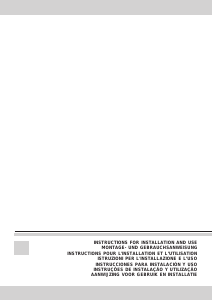


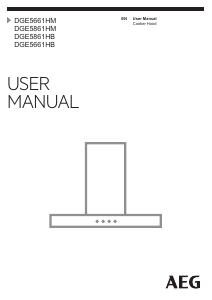
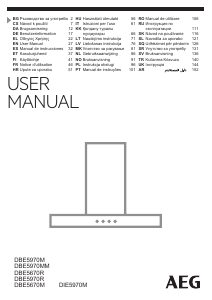
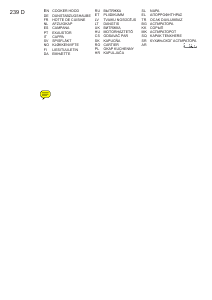
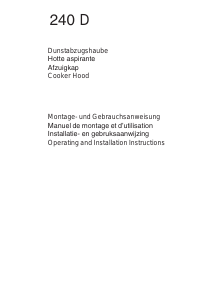
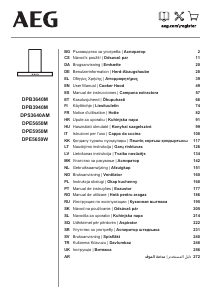
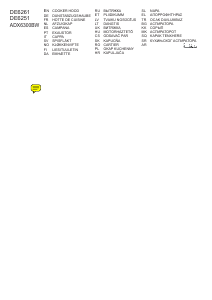
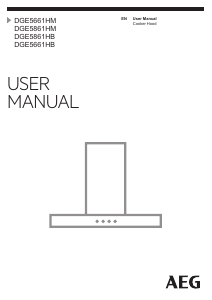
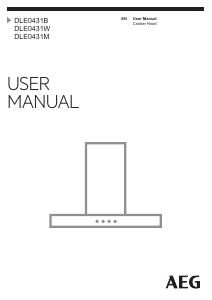
Join the conversation about this product
Here you can share what you think about the AEG 8060D Cooker Hood. If you have a question, first carefully read the manual. Requesting a manual can be done by using our contact form.